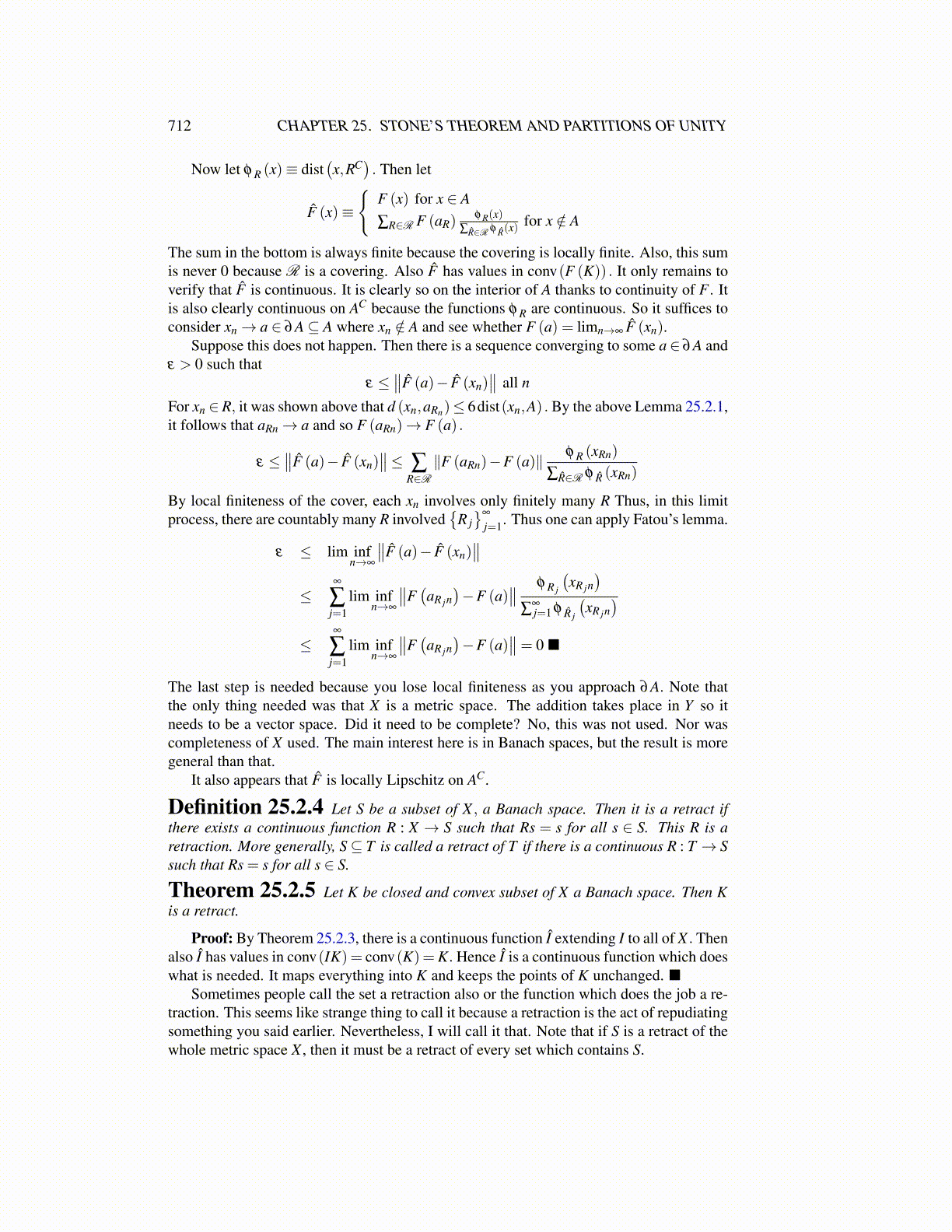
712 CHAPTER 25. STONE’S THEOREM AND PARTITIONS OF UNITY
Now let φ R (x)≡ dist(x,RC
). Then let
F̂ (x)≡
{F (x) for x ∈ A
∑R∈R F (aR)φR(x)
∑R̂∈R φ R̂(x)for x /∈ A
The sum in the bottom is always finite because the covering is locally finite. Also, this sumis never 0 because R is a covering. Also F̂ has values in conv(F (K)) . It only remains toverify that F̂ is continuous. It is clearly so on the interior of A thanks to continuity of F . Itis also clearly continuous on AC because the functions φ R are continuous. So it suffices toconsider xn→ a ∈ ∂A⊆ A where xn /∈ A and see whether F (a) = limn→∞ F̂ (xn).
Suppose this does not happen. Then there is a sequence converging to some a∈ ∂A andε > 0 such that
ε ≤∥∥F̂ (a)− F̂ (xn)
∥∥ all n
For xn ∈R, it was shown above that d (xn,aRn)≤ 6dist(xn,A) . By the above Lemma 25.2.1,it follows that aRn→ a and so F (aRn)→ F (a) .
ε ≤∥∥F̂ (a)− F̂ (xn)
∥∥≤ ∑R∈R∥F (aRn)−F (a)∥ φ R (xRn)
∑R̂∈R φ R̂ (xRn)
By local finiteness of the cover, each xn involves only finitely many R Thus, in this limitprocess, there are countably many R involved
{R j}∞
j=1. Thus one can apply Fatou’s lemma.
ε ≤ lim infn→∞
∥∥F̂ (a)− F̂ (xn)∥∥
≤∞
∑j=1
lim infn→∞
∥∥F(aR jn
)−F (a)
∥∥ φ R j
(xR jn
)∑
∞j=1 φ R̂ j
(xR jn
)≤
∞
∑j=1
lim infn→∞
∥∥F(aR jn
)−F (a)
∥∥= 0 ■
The last step is needed because you lose local finiteness as you approach ∂A. Note thatthe only thing needed was that X is a metric space. The addition takes place in Y so itneeds to be a vector space. Did it need to be complete? No, this was not used. Nor wascompleteness of X used. The main interest here is in Banach spaces, but the result is moregeneral than that.
It also appears that F̂ is locally Lipschitz on AC.
Definition 25.2.4 Let S be a subset of X , a Banach space. Then it is a retract ifthere exists a continuous function R : X → S such that Rs = s for all s ∈ S. This R is aretraction. More generally, S⊆ T is called a retract of T if there is a continuous R : T → Ssuch that Rs = s for all s ∈ S.
Theorem 25.2.5 Let K be closed and convex subset of X a Banach space. Then Kis a retract.
Proof: By Theorem 25.2.3, there is a continuous function Î extending I to all of X . Thenalso Î has values in conv(IK) = conv(K) =K. Hence Î is a continuous function which doeswhat is needed. It maps everything into K and keeps the points of K unchanged. ■
Sometimes people call the set a retraction also or the function which does the job a re-traction. This seems like strange thing to call it because a retraction is the act of repudiatingsomething you said earlier. Nevertheless, I will call it that. Note that if S is a retract of thewhole metric space X , then it must be a retract of every set which contains S.